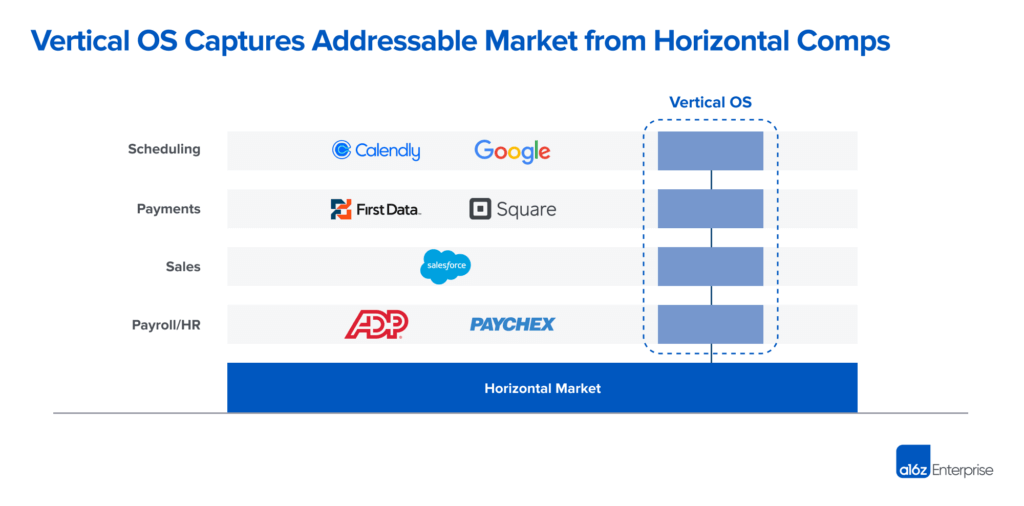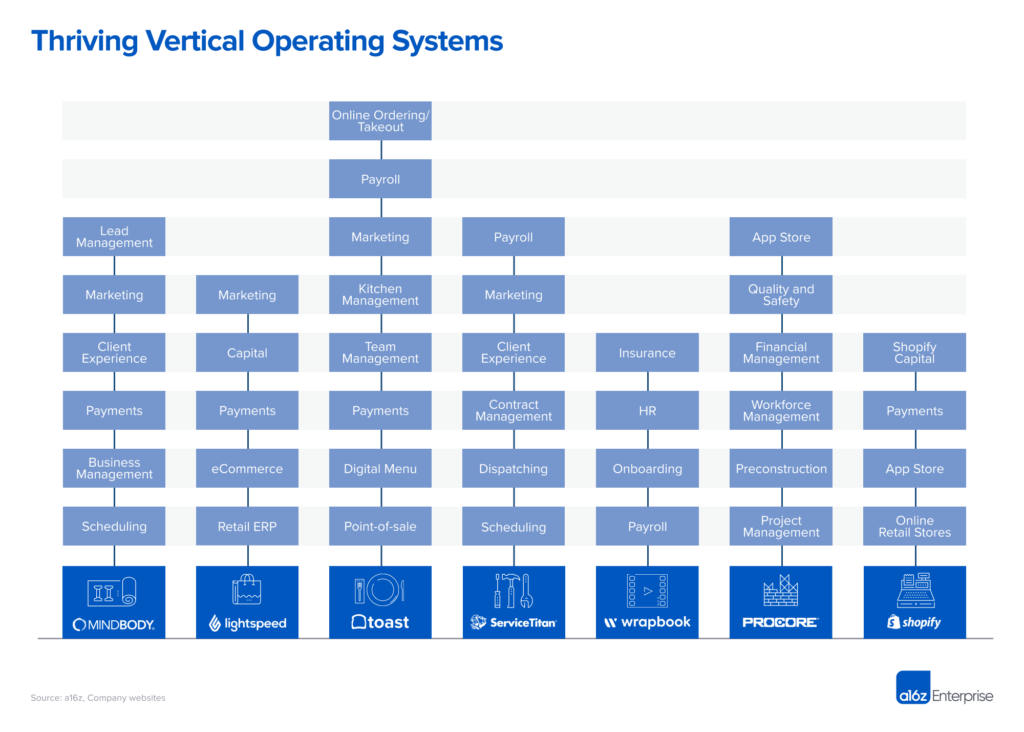When computers were first built, each new application had to be programmed specifically for each chip. This was very complicated for developers and, as a result, the companies that created operating systems to simplify this complexity became some of the most valuable companies on earth. This is true for systems, and it’s also true for companies: Many of the most dominant businesses in the world have built competitive advantages from being the underlying operating systems for their customers.
This post focuses on what constitutes an operating system, with a particular emphasis on vertical operating systems. We believe operating systems are the most valuable system of record, as they own what we call the foundational customer unit and are the base layer for company-wide ecosystems of tools. This is a playbook for building a valuable piece of software that becomes the common interface and source of truth across organizations and even industries.
An operating system is the source of truth plus an ecosystem
An operating system is a particularly unique and valuable system of record, which is another way of saying it’s a source of truth for a collection of data (a database, if you will) that helps a company run. Importantly, an operating system becomes the common interface that other applications build off.
Take Salesforce as an illustrative example. Salesforce is a system of record for sales, customer service, and marketing, but it also helps power and enable an entire ecosystem of software applications that serve its end-customers. This is because Salesforce creates and owns the Salesforce Object, which becomes the foundational customer unit of the business and functions as the unique customer identifier for other software applications.
Imagine a company using Salesforce. The foundational customer unit is the customer ID, or SFID, which is created when a lead enters the marketing system. This is almost certainly either Salesforce-owned (Pardot) or Salesforce-integrated (e.g. Mailchimp). The SFID is then used by all systems that optimize funnel behavior (e.g. Fullstory, Optimizely, etc.). Once a prospect becomes a customer, Salesforce-owned (Service Cloud) or Salesforce-integrated (e.g. Zendesk) customer-support tools all leverage this common SFID in whatever workflow tool is used to handle queries.
This foundational customer unit creates another key aspect of a system of record: It’s ubiquitous, proprietary company information that a future competing business might not have. This makes its products very sticky: If all of a company’s historical information lives within a certain system, and that system powers many other enterprise applications, it becomes very hard to rip that software out. This is why although we love operating systems as much as anyone, we especially love a specific type of operating system — the vertical operating system.
What is a vertical operating system and why is it special?
A vertical operating system possesses the same qualities as a system of record, but with a few key additions that make it a “premium” system of record.
Perhaps the most important distinction is that, like Windows or Macintosh for a computer, there can only be one vertical operating system for a business. The operating system is the layer that stitches together various systems of records and becomes the place an employee spends the most time completing daily activities. This enables an operating system to effectively abstract away other systems of record, as it runs the workflows for the entire company.
A system of record runs a portion of a business, while a vertical operating system runs the entire business.
A good example of this distinction can be shown by contrasting Quickbooks and Toast. With roughly 5.3 million users, Quickbooks is one of the largest systems of record for SMBs in the world, and the largest for accounting. But Quickbooks is not the operating system for its customers. The entire business doesn’t use Quickbooks daily, and it doesn’t own the foundational customer unit. Toast, on the other hand, is the vertical operating system for a specific type of SMB — restaurants — because it owns the daily workflow for all employees and the foundational customer unit, which is, in this case, order and payment data.
Because it owns this information, Toast has the ability to, over time, abstract away other downstream systems of record — like Quickbooks – with proprietary add-on software.
Vertical operating systems couple a wedge with the foundational customer unit
Broadly speaking, vertical markets are seen as less attractive than horizontal markets purely due to market size. This is definitely true for systems of record, in general. But one of our favorite aspects of vertical operating systems is that they can add products and services to shrink the total addressable market of their horizontal competitors, while also increasing their own addressable market. We’ve written extensively about how fintech products can be those additional services, but as our Quickbooks-Toast example illustrates, there are many other software products that can be bundled as an upsell. For example, while Toast is best known for its point-of-sale terminal and ordering system, it also offers payroll, kitchen management, team management, and other software modules. Each of these could theoretically shrink the addressable market for horizontal competitors in those segments, such as Gusto for payroll.
In other words: Almost all vertical operating systems start with a best-in-class wedge product that creates a system of record around the foundational customer unit. And then, from that initial foothold, the company launches other products and services that capture more and more of the employee workflow.
A common playbook revolves around a sales-focused product wedge that has something to do with handling a consumer relationship, where the consumer data is the foundational customer unit. This consumer-based sales product leads to the obvious addition of payments to increase opportunity size, but only makes sense when the wedge product owns the point of sale and there is existing interchange revenue that can be monetized.
In other, often B2B, situations, the foundational customer unit might be, for example, film-industry payroll information (Wrapbook) or construction projects (Procore). In these situations, owning the flow of funds is less relevant, and it might make more sense to add on incremental software or financial services products. For example, Procore added workforce management and financial management, and Wrapbook made it easier to buy workers comp insurance.
These additional elements built off the foundational customer unit are what we see in the most valuable vertical operating systems, and they increase market opportunity size as well as product stickiness.
Regardless of how a vertical operating system might add incremental products, the key to profitably scaling is finding a way to make the go-to-market strategy work with profitable unit economics. If you look at the leading vertical operating systems (e.g. Toast, Servicetitan, or Procore), you’ll notice all of them have annual contract values (ACV) greater than $12,000 (or $10,000 in gross profit when factoring in software and financial service margins). The reason is simple math.
Let’s look at a typical example to understand unit economics for the average account executive (AE). An AE with an annualized quota of $600,000 is closing 60 deals a year, or five deals a month (assuming a $10,000 average gross profit per customer). At any given time, approximately 50% of AE teams are fully ramped (it can take three to six months to ramp an AE to full productivity), so the annualized weighted quota is $300,000. Two-thirds of pipeline for an average SaaS company is driven by outbound (assume a 2:1 SDR:AE ratio) and one-third is driven by inbound (which requires marketing hires to support). Thus, the fully loaded sales and marketing cost for a quota’d AE is $300,000 ($120,000 AE + $60,000 SDR x 2 + $60,000 proportional costs of marketing and sales support) against a $300,000 annualized weighted quota. That’s a 12-month payback on customer acquisition cost.
It’s not impossible to make this model work with smaller deals — for example, inbound pipeline might be higher — but the reality is that account executives can only close so many deals. It’s very difficult to get your sales process efficient enough that quantity of deals will make up for lower-value deals. The focus for companies should be finding a way to get to or beyond that number in annual revenue per customer, and if it’s mission-critical operating system software for reasonably sized or larger businesses, this should be very achievable.
While many horizontal tools can leverage product-led growth, we have found that nearly all vertical operating systems are sold, not bought or tried. The reason being that the average restaurant owner, plumber, or construction general contractor is not actively looking for software products, thus it is harder to grow via product-led growth at scale. The positive trade off is that because they are not actively looking for alternative solutions, vertical operating systems tend to have high retention and lifetime value.
A challenge worth the effort
Operating systems are the most valuable type of systems of record, and there are numerous industries where there is the opportunity to build a vertical operating system. Doing this is challenging, but if achieved is hallowed ground. Just look at Toast and Procore, which each have spent much of the year so far trading at more than $8 billion in market cap (Toast was as high as $13.5 billion at one point). The opportunities to expand and further monetize the customer relationship are numerous, and this expansion opportunity can help make vertical markets larger and more attractive than some horizontal categories.
* * *
-

Joe Schmidt is a partner at Andreessen Horowitz, where he focuses on software, fintech, and insurtech investments.
-

Kristina Shen is a former General Partner at Andreessen Horowitz where she focused on enterprise and SaaS investing.



